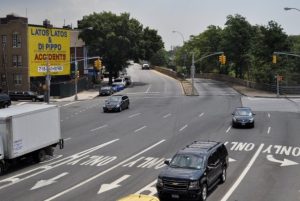
May 13, 2014 By Michael Florio
The Department of Transportation plans to change the traffic flow at the intersection of Astoria Blvd and 31st to reduce accidents.
The agency wants to extend the existing median barrier between Astoria Blvd North and the Grand Central highway exit ramp to separate traffic through 31st Street (see proposal). The plan aims to stop cars coming down Astoria Blvd North from making a left turn on 31st street, while blocking those vehicles coming off the highway from making a right turn.
The DOT, which will be presenting its plan to Community Board 1 next week, claims this change will reduce the likelihood that cars will weave in and out of lanes.
Under current conditions the Grand Central exit ramp merges with Astoria Blvd North. The five-lane road leads to 31st street, giving drivers a short distance to be able to get over and make a turn.
These conditions have led to hasty maneuvers.
DOT Plans for Astoria Blvd North by Queens Post on Scribd
7 Comments

This seems like a good idea but I wonder if drivers needing to make those turns will cause problems elsewhere.
How about thinking smarter and have the exit ramp on a different traffic light and Astoria Blvd timed separately so they don’t merge ever with one being RED while the other is GREEN!
How about getting the semi-trucks and tractor-trailers off of Astoria Blvd between the BQE and the RFK Bridge?
Too many huge noisy trucks in a residential area for no good reason.
How about getting the semi-trucks and tractor-trailers off of Astoria Blvd and letting them use the Grand Central between the BQE and the RFK bridge?
Too many huge noisy trucks in a residential neighborhood for no good reason.
This is the worst intersection in America. The biggest problem is that people in the outer left hand turn lane always try to cut into the inner (thru) lane on 31st as they turn. A cop giving tickets in the area would be nice, but they are all busy parking in the middle of the street and blocking traffic on Astoria Blvd in front of the precinct.
That seems great and all, but what about the people coming from the bridge needing to go down 31st St toward Ditmars. Currently, 33rd St. is used to make a left and then off too 31st St and make a right. This proposal would also mean more congestion on Astoria Blvd South and more left turns on 35th St by the 114th PCT which is only 1 lane. That in itself will cause more traffic.
Foget the hasty decisions, how about the accidents and near misses. Its extremely dangerous there, and very UNSAFE!!